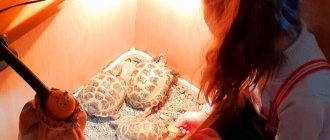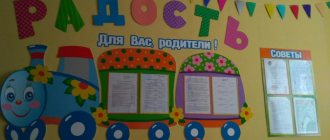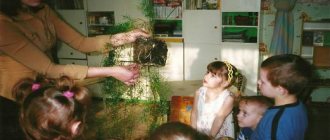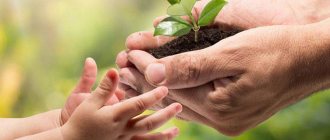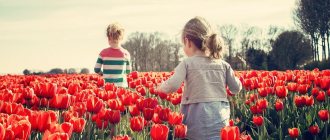Environmental corner in kindergarten. Decor
Decorating an ecological corner in a preschool educational institution with your own hands
Author:
Natalya Yakovlevna Kress, teacher of the Bolsheplotavsky kindergarten, Bolshie Ploty village, Efremovsky district, Tula region. This work is intended for preschool teachers. I want to share my experience of designing an ecological corner. For many years I have been working in a multi-age kindergarten group, where children from 3 to 7 years old are raised, so in the environmental corner I have collected materials that take into account the age of children 3-7 years old. In the group room I built a “mushroom” - a cabinet with manuals. As a mushroom stem I used a small cabinet with shelves, which I covered with self-adhesive film. And I made the hat out of cardboard. She also became a shelf.
In this improvised “mushroom” I placed materials to introduce children to the natural world. Here you can find educational material, children's books about nature, homemade books, seeds and fruits of plants, and herbariums. In the ecological corner there is a book “Indoor Plants”, which we made together with the children. It contains information about indoor plants located in the group room. Each plant is dedicated to one “leaf”, which contains a photograph of the plant and its name, and on the reverse side its description. In the corner, children of senior preschool age can get acquainted with the caterpillar, which will “tell” about the twelve months of the year.
Also in the corner there is a folder with herbariums that we made together with the children. It contains samples of plants from our native village.
All indoor plants were marked with colored circles. I made lists of indoor plants for our group room with labels on separate stands.
On the stump the mole gardener has everything he needs to care for indoor plants.
General view of the ecological corner.
Having such a corner in a group room is very convenient. Didactic material for organizing educational activities or individual work with children is always nearby, at hand. And children can independently look at the pictures and books they like, and play with wild and domestic animals.
We recommend watching:
Mini-museums in my kindergarten group Making a curtain clip with your own hands Organizing play activities in a mixed-age group Organizing play activities in a mixed-age group
Similar articles:
Do-it-yourself group decoration in kindergarten
DIY Autumn panel
“Recommendations for the design of environmental space in preschool educational institutions”
Recommendations for the design of environmental space in preschool educational institutions (nature rooms, nature zones, living corners, winter gardens, etc.)
«Ecological space"
- this is a small area or a separate room occupied by natural objects and having a specific functional purpose. The most traditional “ecological spaces” as forms of organizing a green zone in a kindergarten are group corners of nature.
Recommendations for designing
a nature center in a kindergarten group
The main feature and advantage of the nature center is the close proximity of its inhabitants to children. It can be placed in a group room or dressing room. In early preschool age, the nature center can be decorated with indoor plants and an aquarium with aquatic inhabitants. The fish in the aquarium should be bright, noticeable, large enough so that small children can see them and focus their unsteady attention on them. These could be: goldfish, large swordtails, barbs, angelfish, tetragonopterus. And for a short time you can bring a bird in a cage or a guinea pig.
In middle groups, in addition to an aquarium and plants, the nature center can be decorated with an ornamental bird and a guinea pig, which will allow children to see the diversity of the animal world and ways of caring for living creatures. Suitable birds include canaries and finches. Using the example of a guinea pig, preschoolers learn to come into contact with animals, communicate, and actively care for them. In older groups, the nature center can be decorated with an aquarium with fish, a bird in a cage, a hamster, a turtle and plants. Goldfish and crucian carp are suitable, which will show the good adaptability of a wild animal and its absence in an ornamental variety. In preparatory groups, the nature center is decorated with an aquarium with fish (guppies, swordtails, catfish, barbs); land turtle, golden hamster, bird (budgies); plants. You can also decorate the nature center with a mini-city on the window. The design of the nature center depends on its equipment, which is stored in a closet so as not to disturb the aesthetics.
Nature center capacity:
- Living objects (fish in an aquarium, turtle, etc., temporary objects in a group);
- Equipment for the care of living objects;
- Houseplants;
- Nature calendar;
- Albums and herbariums;
- Fiction about nature;
- Didactic games of a natural history nature;
- Natural materials;
- Education for organizing experiments;
- Models depicting objects and natural phenomena.
Recommendations for decorating
a nature room in a preschool educational institution
In addition to nature centers, a room can be created in the premises of a kindergarten.
This should be a small, clean room where aviaries with birds, large aquariums with various aquatic inhabitants or turtles, large cages with chickens or rabbits should be placed. Plants can be placed on the floor and walls.
The space on the window can be filled by creating a vegetable garden, which requires additional lighting in the form of a lamp. In the window garden you can grow onions, oats, a variety of herbs and vegetables.
Children come to the nature room for different purposes: to observe, to work, to communicate with animals. The room should have workplaces for work, cabinets and shelves for storing equipment, chairs or benches, sitting on which children can watch animals and just relax, while reducing their level of nervous and mental stress.
Recommendations for decorating
a nature room in a preschool educational institution
A nature room is a type of nature room, with the only difference being that the room is also equipped with tables for classes with preschoolers. It can also be used for group work with older preschoolers. That is, the nature cabinet should be decorated in the same way as the nature room, but the addition is tables.
Equally, this “ecological space” can be used for recreation and for in-depth cognitive and educational activities of children and adults, for the moral and labor education of preschoolers.
Recommendations for decorating
a winter garden in a preschool educational institution
Since the winter garden is dominated by plants, the room where it is located should have sufficient lighting and large, spacious windows. In this case, you can grow a wide variety of plants. The winter garden includes exotic plants and fruit plants: indoor lemon, tangerine, decorative pomegranate, feijoa, fig, banana palm, coffee tree, tea bush, laurel, etc.
It is good to arrange a corner of the desert near the southern sunny windows, creating a composition of succulents. If you have a small pool or fountain, you can select moisture-loving plants and create a tropical composition.
You can also find a corner for birds or even an aquarium.
The winter garden, like the nature room, is used for different purposes - for study, work, relaxation and communication with nature. Therefore, the winter garden can be decorated (equipped) with chairs or benches that allow you to relax while watching fish, birds, and plants.
It may contain the following demonstration materials: a set of postcards “Wildflowers”, sets of pictures: fruits, vegetables, berries, trees, domestic and wild animals, birds, mushrooms, fish and plants.
Recommendations for designing
a nature playground at a preschool site
A nature playground is the opposite in its functional significance to a physical education playground. Children can come in small groups to interact with nature in peace and quiet, watch insects, and enjoy the beauty of plants.
In order for the microclimate to be favorable, it is necessary to properly landscape the area, and tall trees and shrubs are planted along the fence, which are a barrier to dust, exhaust gases, strong winds, reduce street noise and create shade on hot summer days. In this case, you should plant different tree species with different qualities: maple has a large and beautiful leaf blade and provides dense shade; ash is interesting for its clusters of seeds that remain throughout the winter; linden is beautiful with its aroma at the height of summer; Rowan blooms beautifully and colors the leaves, produces clusters of berries that attract birds; the aspen's foliage trembles unusually; poplar grows quickly and is a good dust collector; Bird cherry blossoms wonderfully, smells and releases phytoncides.
On the natural site, in different corners, you can arrange a stream, a flower garden, a landscaped gazebo, and a sandy courtyard. Here children can learn to contemplate nature and learn to join in the work of caring for plants and animals.
Recommendations for designing
a coniferous forest on the preschool site
To create a “Coniferous Forest”, it is necessary to plant a bright and free space with coniferous trees - spruce and pine. In the forest you can watch Christmas trees and celebrate winter holidays. It will have its own ecosystem, determined by coniferous trees: cones will attract crossbills and woodpeckers, insects will appear, mosses and lichens will cover the soil, wood sorrel, coppice, club moss will take root, as well as blueberries and hoofed grass. A well-maintained “coniferous forest” will also promote health, as the air will be cleared of pathogenic bacteria.
Recommendations for decorating
an orchard and vegetable garden on a preschool site. The crop
, which can be grown on the site and then collected in the garden and garden, is quite suitable for feeding animals kept in a preschool institution. Fodder root crops and corn salad should be planted in the garden. Cereals can also be planted.
An orchard is always a beautiful sight; In addition, its fruits attract birds, so educational and educational activities can be carried out with children all year round.
Recommendations for designing
flower beds in the preschool area
It is imperative to create flower beds in the preschool. There should be a lot of them: at the entrance to the territory, so that everyone who comes immediately lifts their spirits; in each group plot, so that children can see how flowers grow, care for them and collect seeds, decorate their room with them, etc. In flower beds you can arrange annuals (marigolds, cosmos, marigolds, esholtia, petunia, nasturtium) and perennials (forget-me-nots, golden balls, Jerusalem artichokes, lilies, irises, peonies). from annuals.
Recommendations for setting up
a mini-farm in a preschool educational institution.
A teacher can create a mini-farm, for this you need a barn if small pets in the form of rabbits, chickens, ducks will live there. Next to the barn it is necessary to create a meadow for grazing animals and making hay. Children can participate in various labor operations: giving food, clean water. Or a mini-farm can be a greenhouse in which children and their teacher will plant vegetables.
Recommendations for designing
an ecological trail in a preschool educational institution
Creating a trail must begin with creating a map - a route diagram with planned environmental sites. Then it is necessary to prepare equipment for the new ecological objects of the trail. From object to object you need to lay a path; it can be made of stones, sand, or decorated with the ends of plastic bottles (flowers). If any signs are installed along the route, they should be large and bright. All objects must be aesthetic: clean, beautiful, well-groomed, not broken.
Maintenance of environmental centers in groups of preschool educational institutions
Natalya Sugrina
Maintenance of environmental centers in groups of preschool educational institutions
Ugrina N.F.,
senior teacher
MBDOU No. 102
Maintenance of environmental centers in preschool educational institutions
The aggravation of environmental problems necessitates the formation of environmental consciousness and a culture of environmental management among the population. This work begins in the preschool educational institution, the first link in the lifelong education system.
Preschool childhood is the initial stage of the formation of a person’s personality, his value orientation in the world around him. During this period, a positive attitude towards nature, towards the “man-made world”
, to yourself and to the people around you.
Children's activities cannot be complete outside the subject environment, otherwise the child's desire to learn new things will disappear, apathy and aggression will appear. The surrounding space will help to avoid them, meeting the requirements of the current immediate and long-term creative development of each child, contributing to the timely identification and development of his abilities. An integral part of this space in a preschool educational institution is an ecological and developmental subject environment .
A specific feature of the method of environmental education for preschoolers is the child’s direct contact with objects of nature, “living”
communication with nature and animals, observing them, understanding what was seen during the discussion.
Indirect knowledge of nature (through books, slides, paintings, didactic games, etc.)
is also important: its task is to expand and complement the impressions that the child receives from direct communication with nature.
Therefore, in a preschool institution it is necessary to create environmental centers as important components of the ecological and developmental environment .
The main task of a developing ecological environment is to create conditions for the formation in children of a consciously correct attitude towards nature. The process of developing a consciously correct attitude towards nature is accompanied by independent observations, conducting experiments, and the child’s desire to talk about his experiences and impressions, discuss them, and embody them in various activities.
We have created environmental centers in each group . This allows the teacher to use them throughout the school year to conduct environmental and pedagogical activities and organize various types of children's activities: productive, communicative, labor, play, cognitive-research, musical-art, motor, perception of fiction.
Let's consider the content of environmental centers in the context of children's activities.
To organize productive activities of environmental content , card indexes of models for art activities were created, natural material for construction, attributes for non-traditional drawing, models of natural zones, biocenoses, models based on the works of writers V. Bianki, K. Ushinsky and others were collected. The most various natural materials: chalk, sand, stones, shells, feathers, coal and so on.
To organize gaming and communication activities in groups , games were selected to develop communication skills in preschoolers with environmental content , role-playing games “Tourists”
,
“Underwater World”
,
“Rural Yard”
. The teachers came up with and made various didactic games:
“On a tree - on the ground”
,
“Domestic and wild animals”
,
“Animals and babies”
,
“Match a leaf to a tree”
,
“Anthill and its inhabitants”
,
“Spring flowers”
,
“Day-night”
,
“Monkeys on a tree”
,
“Seasons”
.
Cognitive and research activities play a big role in the development of preschoolers’ cognitive interest and their creative activity. In all groups, scientist corners have been created to organize children's research activities in nature. Even the children of the first junior group , together with the teacher, conduct simple experiments. Microscopes, a globe, laboratory equipment, measuring glassware - all this is of particular interest to children. Children's experimentation not only provides children with an awareness of the connections and dependencies that exist in the natural world, but also provides an opportunity to practically master the basic skills necessary for organizing environmentally competent care for grown plants.
an ecological has been operating for many years - a natural area specially equipped for educational purposes, where conditions are created for educational and research activities. During walks and excursions along the ecological trail, children play , experiment, observe, learn not just to look, but also to see what surrounds them, and to talk about their impressions. They gain skills in time and space orientation and make sketches from life. They develop thinking, speech, memory. And most importantly, a sense of beauty appears, a love for nature is fostered, a desire to protect and preserve it. The green area of a preschool educational institution is of particular importance in an urban environment, where children are maximally isolated from the natural environment.
Each group “window gardens” since February.
, where there are onions, garlic, grain crops, flower seedlings. Children really enjoy watching plants. In addition to observation, they develop a sense of responsibility for the work they have started. The state of nature is noted daily and a corresponding picture is placed on the calendar. We try to encourage children, recognizing the most observant, diligent and active.
To organize work activities in the environmental center , materials and equipment for work activities have been collected (aprons, rags, sponges, oilcloth, spray bottle, watering cans, rakes, etc.) When selecting them, we took into account that materials and equipment must have a quality certificate and meet hygienic, pedagogical and aesthetic requirements.
Musical and artistic activities of environmental content are most fully reflected in the children's holidays “Visiting Autumn”
,
“Water Sorceress”
,
“Meet the Birds!”
,
“Earth Day”
and others. Holding such holidays helps children develop a sense of belonging to all life on the planet and fosters a caring attitude towards nature. During such events, competitions, games, competitions are usually held, exhibitions of children's drawings and photographic materials are organized, which also contributes to children's emotionally positive attitude towards the natural environment.
The environmental center contains works of art about nature: fairy tales, short stories, riddles, poems, proverbs and sayings, as well as models for telling poems and fairy tales.
The success of environmental education and training in preschool educational institutions depends on the use of various forms of work and their reasonable combination. When organizing work in different objects of the ecological and developmental environment, teachers of our preschool educational institution use various methods and forms of work with children, such as: didactic games, systematic observations, creating problem situations, experimental activities, organizing integrated classes, natural history conversations, the use of natural history literature, project activities, organization of excursions and hikes, environmental campaigns, holding holidays and leisure activities, labor activities to care for natural objects.
Thus, as a result of the application of modern approaches to environmental environmental education increases , which is expressed in a qualitatively new attitude towards nature. The leading personal achievement of a child becomes a truly humane attitude towards the greatest value - Life.
Literature
1. Nikolaeva S. Joint activities of adults and children // Preschool education. 2000. No. 5. P. 36-38.
2. S. N. Nikolaeva. Young ecologist : Program for environmental education of preschoolers. – M.: Mosaic-Synthesis. 2004.
3. O. V. Dybina, N. P. Rakhmanova, V. V. Shchetinina. The unknown is nearby - M.: Creative Center Sphere , 2001.
4. N. A. Ryzhova. Not just fairy tales. -M.: Linka-press, 2002.
5. Novoselova S. L. Developmental subject-game environment. // Preschool education. - No. 4. 2005.
Presentation of the ecological corner “Ecolyata-Preschoolers”
An amazing phenomenon of nature is that its educational impact on the inner world of a preschooler is difficult to overestimate, since the child’s soul is fully revealed only in communication with nature. As part of the socio-educational project “Ecolyats - Preschoolers”, an ecological corner was created in our kindergarten, which is a place of educational activity for students, where they have the opportunity to learn to understand the world around them, realize that they are part of it, and establish connections between natural objects. The versatility of the corner lies in the fact that it is available to students throughout the school year; teaching material is updated depending on the time of year; children can clearly see the seasonal changes occurring in nature.
At the top of the corner there is the “Ecolyat” logo, and the owners of the corner are the fairy-tale heroes of the ecolyt, already loved by preschoolers, who help them get acquainted with the world around them.
With Naughty, students play various games and experiment. Research activities are of great interest to preschoolers; for them, experiments are like magic tricks. Children's experimentation not only provides children with an awareness of the connections and dependencies that exist in the natural world, but also provides an opportunity to practically master the basic skills necessary for organizing environmentally competent care for grown plants.
The card index of environmental games created by preschool teachers for each age group helps to diversify the play activities of students.
With Clever Girl, preschoolers read books and solve environmental situations. The ecological corner contains works of art about nature: fairy tales, short stories, riddles, poems, proverbs and sayings, as well as models for telling poems and fairy tales. Throughout the year, various environmental projects are implemented together with children. And the results in the form of layouts, collections, laptops are placed in the corner of the ecology.
With the Christmas tree, children learn to care for indoor plants and pets. In the process of observing natural objects, combined with the work of caring for them, children form ideas about plants, their growth and development, and changes depending on the season.
Also in our ecological corner there is an aquarium with beautiful fish, a turtle and a favorite of teachers and children - the Chilean degu squirrel. The guys watch with interest and look after them.
With Tikhonya, preschoolers collect interesting collections (shells, stones, cones, seeds, leaves, plant fruits) for experimental activities.
The environmental corner contains important information for children and their parents, achievements, reminders, booklets, and colorful pictures. Parents and teachers will learn about upcoming environmental and environmental events, summing up the results of thematic environmental competitions and quizzes from the “Rosinka Environmental News” section.

